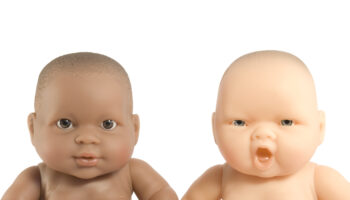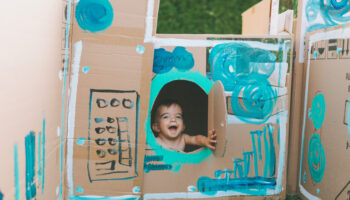Natalie Grebe
As an assessor, I often observe classrooms with many well-stocked activity centers: a kitchen center for dramatic play, a bookshelf with cozy areas, a science center full of magnifying glasses, scales and scoops, along with plenty of puzzles, blocks and vehicles. I also often see puppets! I have loved puppets since I was a teacher. Whether I created my own or used store-bought ones, the puppets were captivating to the children in my class and gave the easily distracted kindergartners something worth focusing on. However, when completing my observations of classrooms over the last few years, I rarely see puppets being used by the children or teachers. While they may be arranged neatly on a puppet stand or propped on a shelf, that is where they usually stay.
Having puppets in the classroom benefits your program in many ways. Puppets can meet expectations for soft toys, multicultural representations, and open-ended play materials. But imagine a classroom where the puppets are taken off the stand and onto the hands of students and teachers. Opportunities to use puppetry exist across subject areas like science and art, as well as a motivator for children to develop listening habits and work to their ability. Some teachers are hesitant to use puppets themselves because they may feel self-conscious. They may need to step out of their comfort zone. In my past experiences with puppets, using them for even a few minutes a day can have a big impact.
According to Willa, author of “Teaching with Puppets in the Early Childhood Classroom,” before using a puppet with the class, “Make a plan. Select, discover a voice and create a personality for a particular puppet” (Bright Hub Education). In my kindergarten class I had a puppet that only visited during journal writing. She would observe each table as the children worked, offering words of encouragement or a sounding board for the child who had difficulty expanding on her topic. When the children left for the day, I would write a short message on a sticky note, acting as the puppet character, and leave it tucked inside a few of the journals. The notes praised the student’s writing, often citing something specific in the child’s journal entry. The next time journal writing took place, the students would be excited to see if they received a note from their puppet friend. This simple task, which only took a few minutes each day, motivated the young writers to add to their stories.
As a teacher, you may be hesitant to allow the children to use puppets because they often become rowdy in the puppet center or do not stay engaged. This is typically because the children haven’t been taught how to properly use puppets. In “Teaching Children to Use Puppets” (Wonder Teacher), author Susan acknowledges that children “end up demonstrating unwanted behaviors: fighting with the puppets, getting loud and silly, spending time off task, etc. The puppet area becomes a hot-spot for misbehavior.” Her article is a fabulous resource for addressing common problems in this area with achievable solutions.
Providing materials for children to make their own puppets is a beneficial, open-ended art activity. Traditional paper bag puppets can be created with a variety of add-on supplies that you likely already have. Popsicle stick puppets can be simple storybook characters that allow children to retell a favorite book. Paper plates and leftover art supplies also provide the makings of affordable new characters.
Using store-bought puppets, such as animals, can assist when teaching about a specific topic. Most 3-year-olds would pay more attention to a monkey telling him or her about where he lives and what he eats to hearing a teacher read a book about monkeys. Science-related themes, such as vegetables or dinosaurs, could be reinforced by using teacher-made puppets. Puppets will help the children to focus on the lesson and allow the teacher to discuss the theme to a greater extent.
Using puppets in the classroom is beneficial to teachers because they provide opportunities to extend learning and improve overall classroom behaviors. Children benefit by making their own puppets because it gives them a creative outlet, promotes self-expression and creates practice with art materials. Speech and language are developed by speaking as a puppet and listening to others perform.
I look forward to observing classrooms of all ages where puppets are used effectively.
Resources:
Teaching with Puppets in the Early Childhood Classroom (www.brighthubeducation.com)
Using Puppets in Childcare (https://articles.extension.org)
Teaching Children to Use Puppets (www.wonderteacher.com)




